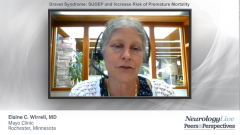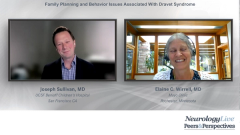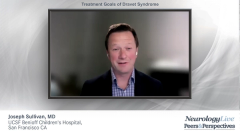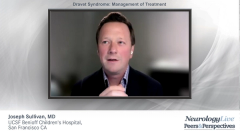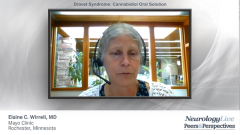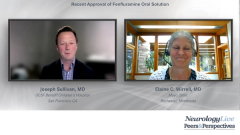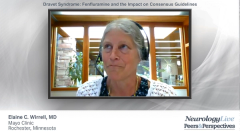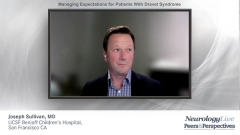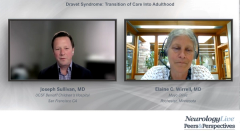
Dravet Syndrome: Cannabidiol Oral Solution
Elaine C. Wirrell, MD, provides an overview of cannabidiol oral solution for treatment of seizures associated with Dravet syndrome.
Episodes in this series

Joseph Sullivan, MD: For the viewers, you’ll notice that we haven’t really talked about some of the newer medicines. I don’t really want to say that we’re being stuck back in our last consensus guideline, but I think it highlights how far we’ve come because when we were finalizing those guidelines, we knew that these other treatments were entering into clinical trials, but we didn’t yet know. We were very, very optimistic that they were going to show efficacy and play an important role in our treatment paradigm, but we didn’t have the data at that time, and so we didn’t want to wait. We wanted to get out what we could at the time but now we have 2 more compounds that I think are very deserving of discussion. So the first that was approved was cannabidiol. I know you’re an investigator on some of the trials and so I’m wondering if you could walk us through that story. It’s such a cool story! And just explain some of the data about efficacy and tolerability.
Elaine C. Wirrell, MD: I think that there was clarity, a lot of interest, a little bit of hype, actually, in the media about what impact medical marijuana could have on Dravet [syndrome]. We know a lot of our families were using sort of more artisanal products or nonpharma grade products, and were reporting benefits from that, but a careful clinical trial had not been done. I think when you’re looking at, “does this really work or not,” we as physicians really want to see the randomized placebo-controlled clinical trial. Unfortunately, we had a pharma company who actually made pharma-grade cannabidiol. It was pure cannabidiol without THC, which I think is really important because I think many of us are a little uncomfortable treating a child with THC, which potentially has more neurocognitive impacts. That clinical trial was done, and it did show that for many patients with Dravet syndrome, add-on cannabidiol was efficacious at reducing seizure burden. Again, complete seizure freedom was pretty rare, but it did reduce seizure burden and it did so with actually very few side effects. The side effects often were fairly mild. They often were self-limited. They would go away with time and many patients had a significant benefit in seizure burden.
Joseph Sullivan, MD: It was. I couldn’t agree more in terms of all the hype, and I believed it. I had no reason to not believe my families that were coming in and sourcing their cannabidiol on their own, and they were not ending up in the hospital, but we really did need this phase 3 data, which was the studies were very well done and multiple studies that reproduce the results that we know that it’s real. I think the fact that it seems to be so well-tolerated [is important]. All of these medicines have their own side effects, but when we look at the ones that we’ve already been discussing, valproic acid and clobazam again, the majority do tolerate them. But you look at cannabidiol and it just did seem to be very well tolerated. I’m not sure if that’s been your experience as well.
Elaine C. Wirrell, MD: It has. I think you have to be a little cautious using it with clobazam. You need to reduce clobazam dose a bit in order to avoid excessive sedation. Some loose stools is typically what we commonly see, but again, for many kids that’s a limited side effect. It goes away on its own.
Joseph Sullivan, MD: Absolutely. It’s exciting. I remember as a pediatric epileptologist, we finally had a new drug that came to market with an indication for pediatrics as opposed to having it be done in adults with partial-onset seizures and have it trickled down to these other syndromes. I think equally fascinating is much like many of the medications that we use just in epilepsy in general, we think we understand the mechanism of action, but interestingly with cannabidiol, there are some theories about it working at this G protein and then these other track receptors and things. It’s called TRPV1 [transient receptor potential cation channel subfamily V member 1] channel. Again, this is getting beyond my basic science knowledge. We suspect that these drugs that work against multiple seizure types, and across syndromes that doesn’t only work for Dravet syndrome. It probably does have many mechanisms that we just don’t understand but as long as we understand the safety profile, I’m OK with that. I’m OK with saying, I don’t know why it works, but it works, and it seems to be safe, so let’s go with it.
Elaine C. Wirrell, MD: I agree. I suspect that a lot of the way we think certain medications work, there’s probably further mechanisms that we don’t understand, and we don’t know yet.
Joseph Sullivan, MD: Exactly. Thank you for watching this Neurology Live® Peers & Perspectives®. If you enjoyed the content, please subscribe to our e-newsletters to receive upcoming programs and other great content in your inbox. Thank you so much.
Transcript Edited for Clarity
Newsletter
Keep your finger on the pulse of neurology—subscribe to NeurologyLive for expert interviews, new data, and breakthrough treatment updates.


